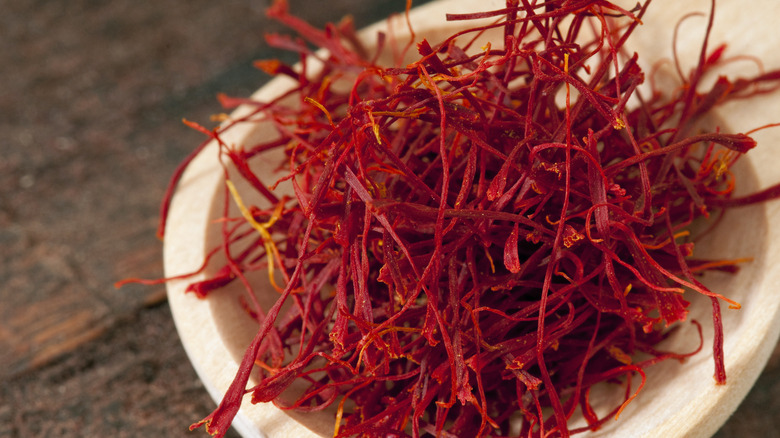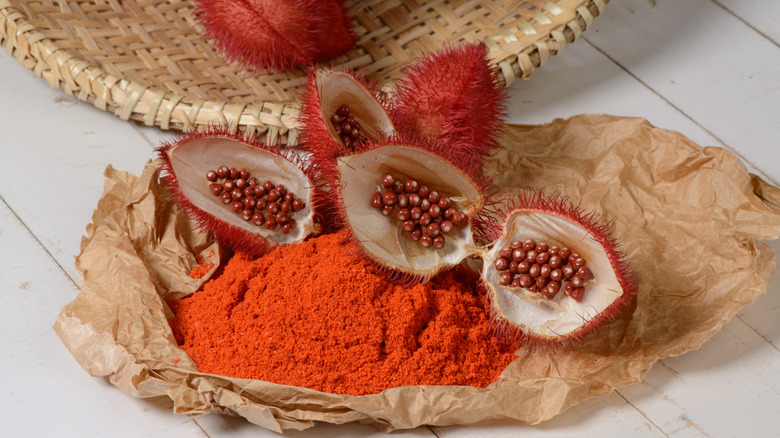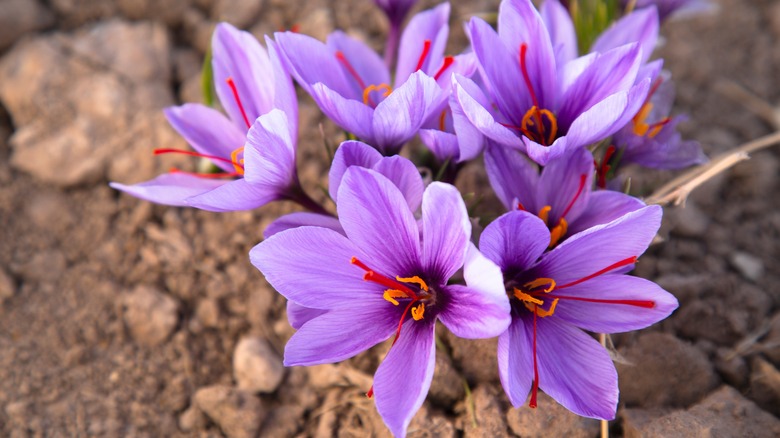The Best Money-Saving Substitute For Saffron
Known as red gold for its hefty price tag, saffron ranks among the most expensive spices in the world. A mere gram of good quality saffron that isn't laced with fake ingredients in disguise can cost between $10 to $20, with finer strands even going for upwards of $1,500 per pound. Safe to say, not everyone may want to invest in a box of saffron — after all, just a pinch of saffron costs a pretty penny. Even if you do decide to buy some, you want to make sure to use the opulent spice sparingly and only in recipes where its absence would be sorely missed. Because in some cases, you might get away with using another, considerably cheaper, spice: ground turmeric.
Ground turmeric is an economical saffron substitute to use when you only want the dark threads for the golden yellow hue that they impart into foods and drinks — think paellas and risottos, for example. Simply swap every large pinch of saffron that the recipe calls for with half a teaspoon of ground turmeric. The only thing to remember is that saffron and turmeric are miles apart in terms of flavor and aroma. Where saffron threads come from a flower and have a sweet and earthy flavor with a floral aroma, turmeric is a root with a hint of metallic bitterness and an earthy but musty aroma. If it's the distinct flavor and aroma of saffron that you want, you might want to shell out the extra bucks.
Other substitutes for saffron
Turmeric is one of the closest substitutes for saffron in terms of its color, and one that's both affordable and likely already sitting in your pantry. You can even spike the turmeric with half parts of paprika to make its flavor more earthy and closer to that of saffron. That said, other alternatives can be used as well. Safflower — also known as Mexican saffron or by its more unfortunate moniker of poor man's saffron — comes from the petals of an entirely different plant but can impart the same rich hue as saffron with slight floral notes. As such, safflower can be used in equal proportions to replace the saffron in your recipe. The same goes for annatto seeds ground into a powder: They can be used in equal ratios to substitute the earthy flavor and deep color of saffron — though it will dye foods more red than yellow.
Safflower and annatto aside, if you're looking for an affordable saffron substitute to use in a pinch, even just paprika or curry powder can come to the rescue. While paprika and curry powder will both dye your foods and drinks much like saffron, paprika will bring an earthy tone whereas the latter will have a stronger and spicier flavor. Saffron can be swapped with paprika using a 1:1 ratio, but go easier when opting for curry powder and only use half the amount.
Why is saffron so expensive in the first place?
Though there are plenty of spices that can replace aspects of what saffron would add to your dish, the question remains: What is it about those red threads that make them so darn expensive? Likely native to the Mediterranean, parts of Asia, and Iran (which is where most of the world's saffron comes from), saffron strands are the stigma of the purple-colored saffron or Crocus sativus flower. The main reason why saffron is so expensive is because each flower only produces three stigmata — aka three strands of saffron. So that pound of saffron which costs upwards of $1,500? That takes 75,000 flowers to make!
To add to that, saffron flowers aren't the easiest things to grow or harvest. Saffron flowers only bloom for two to three weeks in a year and when they do, they stay in full bloom for no more than two days. Once bloomed, time is of the essence. Saffron flowers bloom at dawn and start to wither away under the sun, meaning there's a very short window to pluck those high-priced strands out. Plus, the stigmata are so fragile that they must be plucked out by hand. The result is a harvest process so labor-intensive and time-consuming that it takes as many as 470 hours of hard labor to gather a mere pound of saffron. When you consider all that, saffron's reputation as one of the world's most expensive spices doesn't seem all that astonishing.



